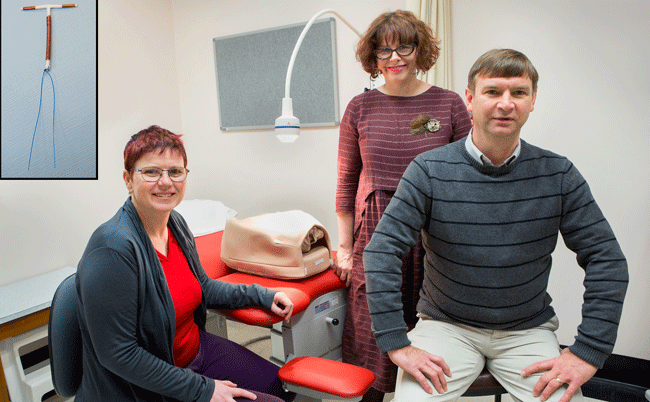
The 2019 Proof of Concept competition winners (from left) Helen Paterson, Emma Macfarlane and Michael Stitely of the Department of Women's and Children's Health. Photo: Sharron Bennett.
A device that could help decrease the global burden of unwanted pregnancy has won Otago Innovation Ltd's $60,000 Proof of Concept competition for 2019.
The device, designed by a team in Otago's Department of Women's and Children's Health, will make it safer and easier for birth attendants, such as midwives, to insert an intrauterine contraceptive device (IUD) immediately after a woman gives birth.
"We attended an IUD training session for registrars and saw how difficult they found inserting them in a simulation model. We thought: There has to be a better way."
These small, T-shaped devices offer up to 10 years of contraception and are inserted in the uterus through the cervix. The best time to insert them is straight after birth, however, the current method requires surgical skills, dramatically limiting their use.
This is where Associate Professor Michael Stitely and his team come in.
“We attended an IUD training session for registrars and saw how difficult they found inserting them in a simulation model,” he says. “We thought: There has to be a better way.”
So, they went about finding one.
Dr Stitely sketched an idea for a device that would assist with the insertion on a scrap of paper. Then he and his team drew it up using a computer assisted drawing (CAD) programme, and created a rough prototype using their desktop 3D printer.
Seventeen adjustments and re-prints later they have a device they believe fixes the problem.
“It was great to be able to hold it in our hands and make changes to dimensions and shapes until we got it right. But actually, it's not a lot different from that initial scrap paper drawing. The changes are all fractions of millimetres.”
Otago Innovation's Intellectual Property Manager and Patent Attorney Tomas Ribeiro, who was one of six judges in the competition, says the standard of entries was extremely high this year, making it difficult to pick a winner.
"We're very excited to work with Otago Innovation to advance this to clinical product. It will move up our time frames considerably. We can start working on next steps immediately."
There were 17 entries, of which 13 were shortlisted for presenting. Projects ranged from the winning medical device, through to drug development, agri-tech, marine, dental, maths and others.
“But Michael's idea stood out when the judges sat and spoke,” he says. “It solves a very real clinical problem.”
Dr Stitely says he and his team are thrilled to win, and have this opportunity to progress this idea to its next stages.
“We're very excited to work with Otago Innovation to advance this to clinical product. It will move up our time frames considerably. We can start working on next steps immediately.”
Four projects were highly commended this year. They were Rowan Herridge (Biochemistry), Gemma Cotton (Dentistry), Sean McKay and Wayne Dillon (both Chemistry).
Mr Ribeiro says while Dr Stitely's project is guaranteed money, others are likely to receive investment from Otago Innovation, and a large proportion are currently being assessed for commercial applicability.
About the device:
What:
- A device to assist the insertion of an IUD immediately after the delivery of the placenta. This device makes it both safer and easier.
Why:
- Immediately after delivery is the best time – because the cervix is already dilated – making it less painful and more likely to succeed.
- The current method requires surgical skills, greatly limiting its use.
- There is a world-wide push to increase the use of IUDs particularly in developing countries.
- This device can be used by GPs, midwives and non-specialist trained birth attendants.
Statistics from the World Health Organisation:
- Women's motivation to initiate contraceptive use in postpartum period is high.
- Up to 100,000 maternal deaths per year could be avoided if effective contraception was used by those who didn't want children.
- Preventing unintended pregnancy could avert the loss of 4.5 million disability adjusted life years.
